
Windy Volkswagen Vento
Content
Volkswagen's marketers love to assign sonorous wind-related names to factory cars - Passat, Bora, Sirocco, Jetta. The same "windy" car was the Volkswagen Vento. This model owes its name to the Italian word for "wind". Whether the founding fathers wanted to put a specific meaning into the project or not is not clear. But the car turned out to be a solid German Das Auto.
Volkswagen Vento Review
Entering the market for a car with a new name is a big risk for the automaker. The battle for the recognition of the new brand has to start all over again and it is far from a fact that the car will find its consumer. But the Vento is really nothing more than the third generation Volkswagen Jetta, but under a new name. The same car in the American market did not change its name and was sold as "Jetta 3".
How Vento was created
Cars of the Jetta family were originally conceived as a modification of the popular Golf in a sedan body. Probably, the developers believed that such a car would be in demand by Golf fans who needed a roomy trunk. But in reality, the Jetta lineup did not shine with particular popularity in Europe. What can not be said about the North American market. Apparently, therefore, in the American market, the Jetta remained under its own name, and in Europe it suffered the throes of rebranding. "Jetta" 4th generation also received a new name - "Bora".
The first "Jets" left the assembly line back in 1979. By that time, the Volkswagen Golf I, which became the prototype for the Jetta, had been in production for 5 years. This period was necessary for the designers to think over the optimal configuration of the body and prepare the production base for the release of the new sedan.
Since then, every release of the next generation of "Golf" was marked by the renewal of the Jetta model range. In the future, the time gap between the release of "Golf" and "Jetta" of one generation was reduced and amounted to no more than a year. This also happened with the Volkswagen Vento, which began rolling off the assembly line in 1992. Just a year after the entry into the market of its brother - "Golf" 3 generations.

In addition to external similarity, the Vento inherited the engine, chassis, transmission and interior from the Golf. The external appearance of the Vento has acquired more rounded and smooth features than the predecessor of the Jetta II. Gone are the round headlights. Optics acquired a strict rectangular form. Salon has become more spacious and comfortable. For the first time, an anti-lock braking system (ABS) was installed on machines of this family. The designers paid much attention to the protection of the driver and passengers. In addition to the already familiar airbags, the following set of elements is installed:
- easily crushed deformation zones;
- protective profiles in the doors;
- power frame;
- deforming steering column;
- styrofoam in the dashboard.
The base model had a four-door design. Two-door "Vento" were produced in a small series, but they did not receive wide distribution. It was planned to produce a station wagon under the Vento brand. But in the end, the management of Volkswagen left this body under the Golf brand.
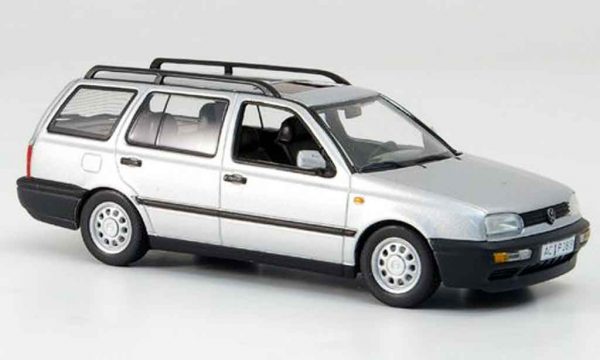
The Vento production continued until 1998 and resumed in 2010 in India. True, this Vento has nothing to do with the Jetta family. This is an exact copy of the Polo produced in Kaluga.
Description of the model
Just like Golf III, Vento belongs to the C-class of compact cars and has the following weight and dimensions:
- weight - from 1100 to 1219 kg;
- carrying capacity - up to 530 kg;
- length - 4380 mm;
- width - 1700 mm;
- height - 1420 mm.
In comparison with its predecessor, the 2nd generation Jetta, the weight and dimensions of the new model have changed insignificantly: the dimensions of the body are within 5-10 mm, the carrying capacity remains the same. But the weight has added more than 100 kg - the car has become heavier.
The line of power units is also taken from the third generation "Golf" and includes:
- 4 diesel engine options with a volume of 1,9 liters and a capacity of 64 to 110 liters. With.;
- 5 versions of the gasoline engine with power from 75 to 174 hp. With. and a volume of 1,4 to 2,8 liters.
The most powerful VR6 gasoline engine in the range allows speeds up to 224 km / h. It is the equipment with this engine that is most popular among fans of sports driving. The average consumption of gasoline on such an engine is about 11 liters per 100 km. The consumption of other gasoline engines does not exceed 8 liters, and the speed does not exceed 170 km / h. Diesel engines are traditionally economical - no more than 6 liters per 100 km.
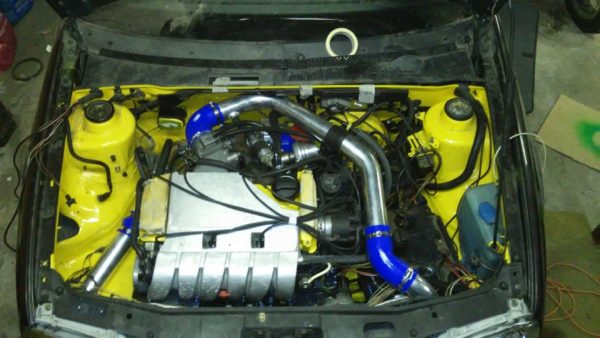
For the first time, a 1,9-liter TDI diesel engine with a power of 90 hp began to be installed on the Vento / Golf III. With. This engine has become the most successful Volkswagen diesel engine in terms of efficiency and reliability. It is thanks to this model of the power unit that Europeans have become supporters of diesel engines. To this day, all two-liter Volkswagen diesel engines are based on it.
The car is equipped with two types of gearboxes:
- 5-speed mechanics;
- 4-speed automatic.
The Vento suspension is also identical to the Volkswagen Golf III. Ahead - "McPherson" with anti-roll bar, and at the back - a semi-independent beam. Unlike the Vento, the Jetta II used an independent spring suspension on the rear axle.
Repair of Volkswagen Vento
Unlike Volkswagen Golf, the Vento brand is not well known to most Russian motorists. Unfamiliar names usually make the future car owner wary. The more unique the car, the more difficult it is to find a spare part for it. But with Vento, these fears are unfounded. Given Vento's golf roots, parts are fairly easy to find.
Moreover, many parts come from Russian cars. This mainly applies to little things - rubber bands, gaskets, light bulbs. But there are also important elements, for example:
- VAZ fuel pump by Pekar;
- vacuum brake booster from VAZ-2108;
- the main brake cylinder from the VAZ-2108 (it is necessary to install a plug on the opening of the primary circuit);
- power steering belt from Lada Kalina;
- anthers of the tie rod ends from the VAZ "classics".
Over the 25-year history of "Vento" Russian car services have accumulated solid experience in the repair of this car. Most auto experts point out as weak points of Vento:
- turbine;
- silent blocks and rear suspension springs;
- electric idle speed controller;
- bearings of the primary and secondary shaft in the gearbox;
- leakage in the cooling system in the area of the junction of the pipes with the engine.
One of the troubles of the car is its low corrosion resistance. It is very difficult to find a Vento with a quality body in the secondary market. But fans of this brand are not afraid of rust. As a rule, such a car is chosen by lovers of fast driving and sports tuning, and repairs for them are a common thing.
Video: Volkswagen Vento steering rack repair
Tuning "Vento" to the face
No matter how good the car is, but perfection knows no bounds. The simple and rude design of "Vento" provokes the owner, who is not indifferent to the car, to perform creative feats. And often tuning even enhances the notes of brutality in the external appearance of the car.


The most popular types of tuning for "Vento" are:
- tinted glass;
- installation of sports bumpers and body kits;
- changing the radiator grill;
- installation of non-standard headlights;
- wing;
- tuning of the chassis;
- engine tuning.


The owners of "Vento" love to hide the true face of the car. Not every automotive connoisseur will immediately determine what kind of brand it is.
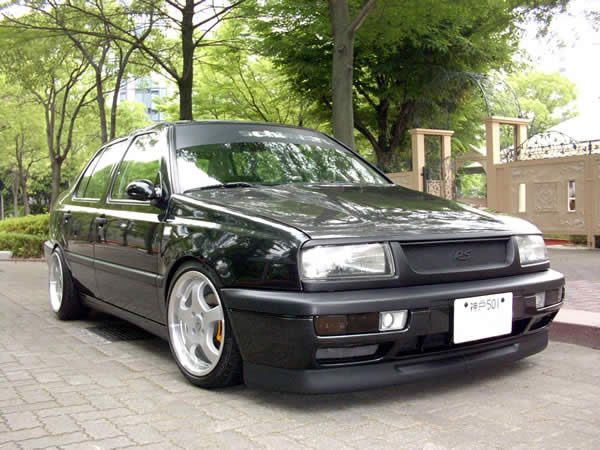

Where to start tuning Volkswagen Vento
Man is so constructed that he thinks more about the external form than about the internal content. The same approach is projected for car tuning. The owners of "Vento" are trying to start improving the car from the exterior.
Improving the exterior should start with an assessment of the body paintwork. Any car loses its original factory shine over time, but what can we say about a car that is at least 20 years old. Sports bumpers, tinting, alloy wheels are unlikely to be combined with a faded body. The ideal solution would be to paint the entire body, but this is an expensive option. To begin with, you can pre-restore the coating using various cleaners and polishes.
It is important to remember that complete car tuning is a costly process. The cost of work and materials often exceeds the price of the machine itself. Therefore, many car enthusiasts break this process into stages.
The simplest tuning that is available to everyone is the replacement of headlights and a radiator grill. Manufacturers of auto-tuning parts offer a wide range of such products. The cost of the radiator grill is approximately one and a half to two thousand rubles.


Headlights will cost much more - from 8 thousand rubles. It is important to remember that there are a lot of low-quality spare parts on the market, and the low price is one of the characteristic signs of this.


Phillips and slotted screwdrivers are required to replace the headlights and grille. The work itself will take about 10-15 minutes, for this you need:
- Open the hood.

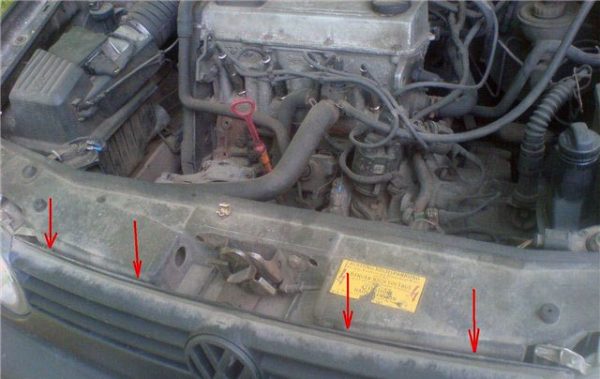 The arrows show the location of the radiator grille latches
The arrows show the location of the radiator grille latches - Using a slotted screwdriver, disconnect the grille fastening latches.

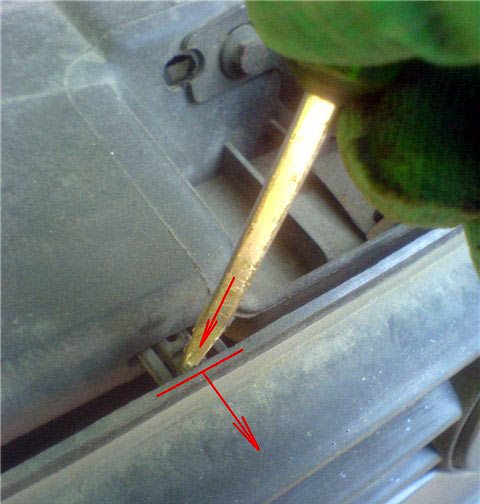 Remove the grille very carefully, plastic latches often break
Remove the grille very carefully, plastic latches often break - Loosen the four headlight mounting bolts.

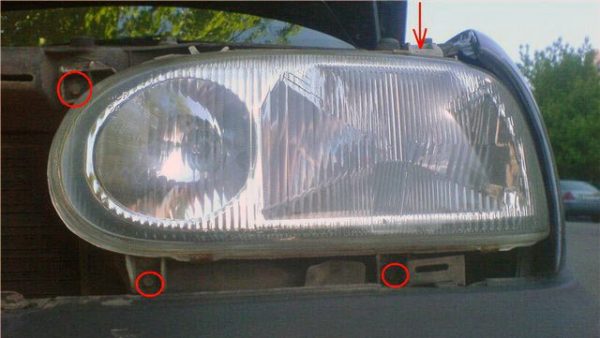 The headlight is mounted on four bolts (marked with red circles and an arrow)
The headlight is mounted on four bolts (marked with red circles and an arrow) - Disconnect the power and corrector connectors and pull out the headlight.

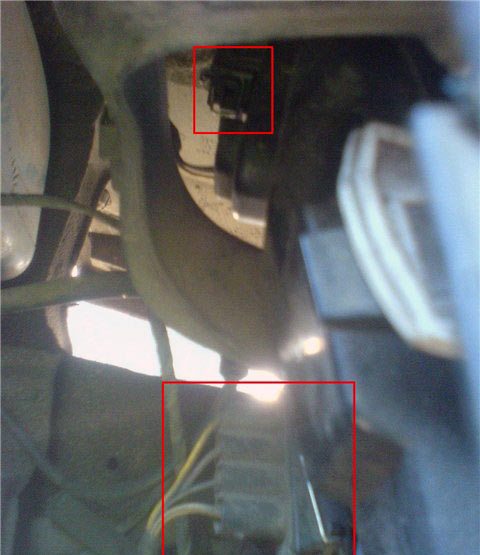 In the background is the connector for the hydraulic corrector
In the background is the connector for the hydraulic corrector Install new headlights and grille according to p. 1-4 in reverse order.
After replacing the headlights, it is necessary to adjust the luminous flux. To do this, it is better to contact a specialized service that has the appropriate equipment.
Installing new headlights and grilles will help freshen up the car's appearance.
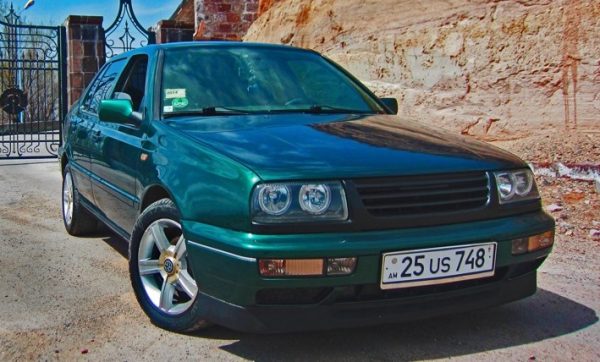

Video: what becomes "Vento" after tuning


Watch this video on YouTube
Volkswagen Vento was created at a time when the views of designers on the life cycle of a car differed from today's ideas. The machines were laid increased margin of safety and reliability. It is no coincidence that cars of the nineties and even eighties, preserved in working order, are in steady demand among experienced motorists. And in this series, the Volkswagen Vento is not the last. German reliability, maintainability and scope for tuning make Vento a profitable purchase for both a resident of the outback and an urban car lover.


One comment
sibghatullah
Thank you for sharing this information with us. This information is not available in PDF format. Thank you for downloading.